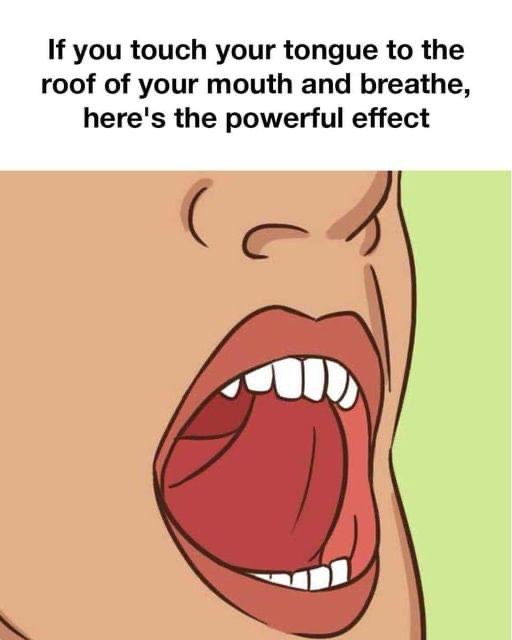
Breathing is typically something we do without much thought. However, certain techniques can transform it into a tool for managing anxiety, enhancing focus, and even improving sleep. Placing your tongue on the roof of your mouth while breathing is one such technique that has roots in ancient practices like yoga and qigong.
In Eastern traditions, this tongue position is referred to as creating a “microcosmic orbit.” It involves connecting the governing and conception vessels—energy channels that run along the spine and front of the body. While the idea of energy channels is more spiritual in nature, modern science can still explain why this positioning affects the body so profoundly.
Nasal Breathing Activation: Placing your tongue on the roof of your mouth encourages nasal breathing. Nasal breathing is inherently more beneficial than mouth breathing because it filters, humidifies, and warms the air, making it easier on your lungs. It also engages the diaphragm more effectively, allowing for deeper and more controlled breaths. This type of breathing supports optimal oxygen exchange, which has a calming effect on the nervous system.
Vagus Nerve Stimulation: The placement of the tongue on the roof of the mouth is said to engage the vagus nerve, which plays a major role in regulating the parasympathetic nervous system, responsible for rest, digestion, and relaxation. Stimulating the vagus nerve can help lower heart rate, reduce blood pressure, and promote a feeling of calmness
Enhanced Focus on Breath Control: By consciously positioning the tongue, you naturally shift attention to the breath, leading to greater mindfulness. This brings a meditative element to breathing, which can help clear mental clutter and enhance focus.
Step-by-Step Guide to the Breathing Technique
To practice this technique, follow these simple steps:
Find a Comfortable Position: Sit or lie down in a relaxed posture. Keep your spine straight but not tense.
Close Your Mouth and Relax Your Jaw: Gently close your mouth, allowing your teeth to remain slightly apart, and rest your tongue against the roof of your mouth, just behind your front teeth.
Breathe in Slowly Through Your Nose: Focus on taking deep, slow breaths. Inhale for about 4–6 seconds.
Hold the Breath: Hold your breath for 4–6 seconds, depending on your comfort level.
Exhale Slowly: Let the breath out slowly through your nose for 6–8 seconds, feeling the relaxation in your body as you release tension.
Repeat: Continue this cycle for 5–10 minutes.
The Powerful Effects of This Breathing Technique
1. Stress Reduction
One of the most immediate and noticeable effects of this breathing technique is its ability to reduce stress and anxiety. Controlled breathing lowers cortisol levels (the stress hormone), which can bring immediate relief in situations of tension or panic. Stimulating the vagus nerve through proper breath control and tongue positioning activates the parasympathetic nervous system, helping to counteract the fight-or-flight response.
2. Improved Focus and Mental Clarity
By placing your tongue in this position and breathing mindfully, you bring your attention inward. This heightened focus on the breath has been shown to improve concentration and mental clarity. Deep breathing increases oxygen flow to the brain, which improves cognitive function, enhances problem-solving skills, and helps clear mental fog. Many people use this technique before important tasks like exams, presentations, or even during meditation to center their mind.
3. Better Sleep Quality
People struggling with insomnia or restless sleep often find that breathing techniques can significantly improve their rest. When you combine the calming effects of vagus nerve stimulation with the mindfulness of breath control, the body is primed for relaxation. Practicing this technique before bed can calm a racing mind, lower heart rate, and prepare the body for deeper, more restful sleep.
4. Enhanced Respiratory Efficiency
Touching the tongue to the roof of the mouth promotes nasal breathing, which offers various benefits over mouth breathing. Nasal breathing encourages the production of nitric oxide, a molecule that helps dilate blood vessels and improves oxygen circulation in the body. This improved oxygenation leads to better energy levels, enhanced stamina, and reduced fatigue throughout the day.
Additionally, it encourages diaphragmatic breathing—also known as “belly breathing”—which supports lung capacity and overall respiratory efficiency. Athletes often incorporate this breathing method into their routines to boost endurance.
5. Emotional Regulation and Mood Improvement
This technique has a grounding effect on emotions. Focusing on the breath creates a calming rhythm that can reduce feelings of anger, frustration, and overwhelm. Consistent practice is linked to the release of endorphins, the body’s natural “feel-good” chemicals. Thus, this breathing method not only reduces anxiety but can also boost overall mood and emotional resilience.
6. Improved Cardiovascular Health
Stimulating the parasympathetic nervous system through mindful breathing has cardiovascular benefits as well. Regular practice of this technique can help lower blood pressure and reduce heart rate variability, which is associated with a lower risk of heart disease and stroke. By calming the body’s stress response, this breathing method helps maintain heart health over time.